Some fun with a (very) simple matrix
Posted by: Gary Ernest Davis on: February 20, 2011
Geometry of a transformation
The matrix
is very simple: it has entries consisting only of 0’s and 1’s.
As a matrix we can think of
as transforming points in the euclidean plane. These are points with coordinates
where
are real numbers.
The matrix transforms the point
into the point
:
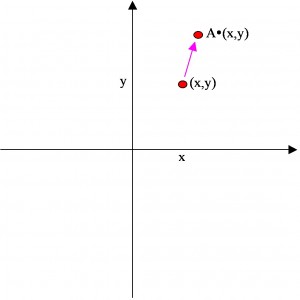
We can look at what the matrix does to geometric shapes in the plane.
For example, the square with corners – show in yellow in the diagram below – gets transformed into the parallelogram with corners
– shown in purple dots in the diagram below:
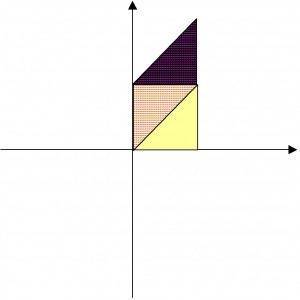 The area of the parallelogram is 1 unit – the same as the area of the original square. Because area of any plane figure is based on counting squares – and taking a limit with vanishingly small squares if the figure is somewhat round, such as a circular region – the matrix
The area of the parallelogram is 1 unit – the same as the area of the original square. Because area of any plane figure is based on counting squares – and taking a limit with vanishingly small squares if the figure is somewhat round, such as a circular region – the matrix is an area-preserving transformation of the plane.
However if we imagine traveling counter-clockwise from the point to the point
we see that the transformation
has us traveling clockwise from
to
:
In other words, the matrix is an orientation-reversing transformation of the plane.
Appearance of the Fibonacci numbers
What happens when we apply the matrix over and over to a point?
For instance, if we apply the matrix to the point
 we get the point
, and if we then apply
to this new point we get the point
.
This is the same result as if we had applied the square to the point
.
This is true more generally: to figure out what applying the matrix over and over does to a point
, it is the same as working out the appropriate power of the matrix
and applying that matrix to
.
So can we characterize, or identify, the powers of the matrix ?
Here are the first few powers:
x
x
x
x
These matrix entries are looking suspiciously familiar: they are looking like the Fibonacci numbers
Have we just been lucky so far, or is this something we can prove?
A good proof technique for this sort of problem is proof by induction, because we know inductively how to work out the powers of the matrix , namely
.
First, we need a precise statement of what it is we are trying to prove.
It’s looking like:
where
are the Fibonacci numbers given by
, namely
x
This is certainly true for because
So let’s suppose that it’s true for some particular value of , say
(for example:
).
Then
so our statement is true also for . By the principle of mathematical induction, it is true for all
.
Moving to a torus
The matrix has the property that it sends points in the plane with integer coordinates to similar points:
so if
are integers then so are the coordinates of
.
This means we can restrict as a transformation of the unit square with corners
so long as we keep only the fractional parts of the coordinates of points.
For example, the point lies in the unit square but it’s transformation by the matrix
does not:
. So we reduce the result by keeping only the fractional parts of the coordinates:
.
This operation, of reducing coordinates by keeping only the fractional parts is called reduction modulo 1.
Wwe write the result of keeping only the fractional parts of the coordinates of the point as
When we think about this for a moment we see that some apparently different points on the unit square are actually the same, modulo 1.
For example, any point of the form is the same, modulo 1, as the point
.
Ditto, any point is the same, modulo 1, as the point
.
This means the sides of the squares, are really the same line, modulo 1:
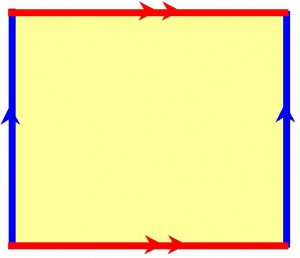 We can get a different picture of the unit square, modulo 1, if we glue together points on the square that are the same modulo 1.
We can get a different picture of the unit square, modulo 1, if we glue together points on the square that are the same modulo 1.
First we can glue corresponding points on the blue sides to get a cylinder:
Now, when we glue together the red ends of the cylinder, as indicated, we get the surface of a donut, otherwise known as a torus:
So now we can use the matrix to transform points on the torus, so long as we remember to reduce the coordinates of the points modulo 1.
What happens if, for example, we begin with the point and keep applying the matrix
over to the result?
x
(remember we are reducing modulo 1)
x
x
x
x
x
x
x
x
x
x
x
and we are back to where we started, after 13 steps.
The collection 12 points we collected along the way: is called the orbit of the initial point
.
Any of the points in the orbit of has exactly the same 12 points as its orbit. This is because the matrix
is an invertible matrix with inverse
Just as for the point we chose, any point on the torus with rational number coordinates will have a finite orbit.
Question 1: Can you see why this is so?
Question 2: Can you figure out the size of the orbit of the point from the numbers
?
Wherever we are on the torus there is a point nearby – as close as we wish – that has rational coordinates. Therefore, wherever we are on the torus there is a point nearby – as close as we wish – with a finite orbit.
Arnold’s cat map
The square of the matrix , namely the matrix
is known as Arnold’s cat map.
This matrix gives us an area-preserving, orientation-preserving transformation of the torus, that like the matrix is technically chaotic.
What this means in practice is that when we take two points on the torus that are very close together, and examine points in their orbit we will soon find corresponding points that are quite far apart.
Then as we progress through the orbits we will find the points get back close together again.
Vladimir Arnold visualized this by imagining a picture of a cat drawn on the torus and seeing what happened to the cat as we repeatedly applied the matrix transformation .
The cat would at first get spread all over the torus but would eventually become almost reconstructed.
A lovely account of Arnold’s cat map appears in the article “Period of a discrete cat mapping” by Freeman Dyson and Harold Falk.
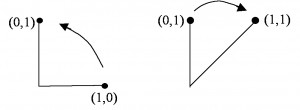
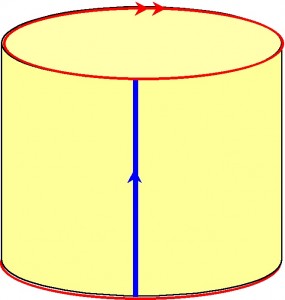
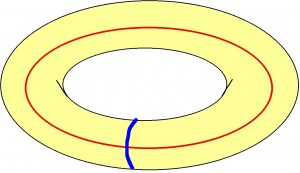


Leave a Reply